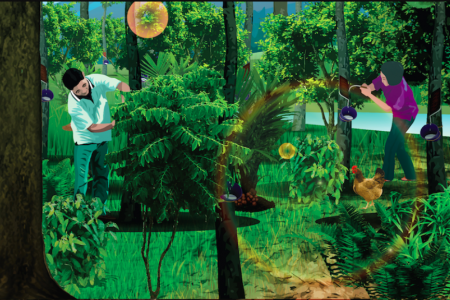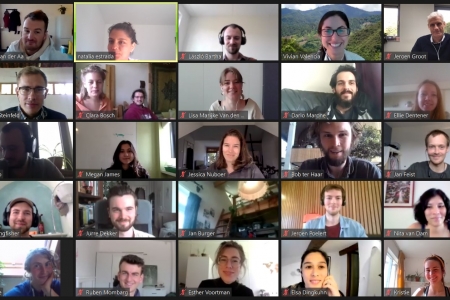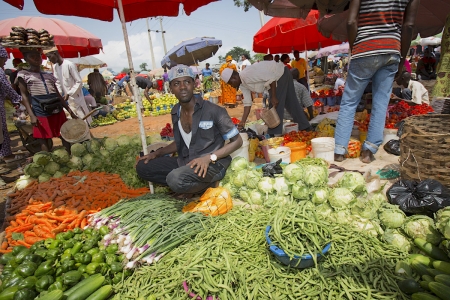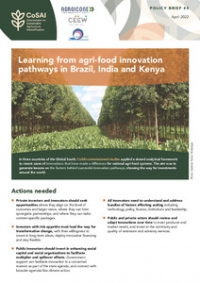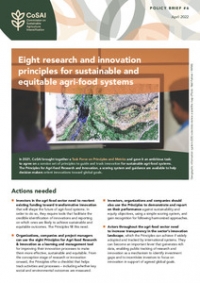42° in the shade is really hot. These sweltering conditions are faced daily by small-holder farmers tending their dry season vegetable crops in the White Volta Basin. In April, Targeting Agricultural Innovation (TAI) researchers visited communities in this region to determine how small dam systems could be made more resilient to increasing sedimentation. Doing so will ensure that they can continue to provide dry season food and nutrition security to these communities.

This year at Bedega, Burkina Faso, farmers who had decided to plant maize for seeds are adjusting their expectations and writing off the maize as forage as the reservoir level passes the locally agreed irrigation limit for ensuring water for livestock. Could water be allocated more carefully to meet the demands of all users throughout the year? Or has increased sedimentation and demand for water outgrown the reservoir’s shrinking capacity?
Case in point at Lagdwenda, Burkina Faso, where the community is alarmed by the unprecedented rate at which the reservoir is filling with sediment. Just how quickly is this sand being deposited and how much longer will the reservoir be able to provide irrigation water without a concerted dredging effort? What are the options available to the community to reduce this sedimentation? Can managing the soil conservation services of upstream land use types provide a scalable solution?
These are some of the questions and conflicts that the WLE TAI team faced during their April field mission. Seven communities were visited by members of the TAI team, including Binaba, Bedega, Lagdwenda, Nafkuliga, Tanga, Widenaba and Zongoyiri. Strategies for natural resources management and identification of critical places where farmers conduct their activities were discussed with the local communities and decision makers through participatory processes.

The White Volta
The White Volta stretches from Burkina Faso to Ghana, forming one of the major tributaries of the Volta River. More than 1500 small reservoirs dot the White Volta basin collecting rainfall and runoff during the rainy season and storing it for use through the dry season. This storage and use underpins the livelihoods of hundreds of farmers, pastoralists and fishermen throughout the region.
The TAI project brought new research technologies and instrumentation to six dams in the region as part of an effort to improve capacity to identify sources of environmental degradation. It is working with communities to identify locally-relevant ecosystem service based interventions to improve and restore small dam capacity in order to support local and regional livelihoods and well being. Collaborations with the Volta Basin Authority will further use modeling approaches to test the scalability and impact of these interventions.
It is often difficult to scale the impact of field level interventions to landscape level processes. The rapid rise of remote sensing technologies is providing tools that help overcome this barrier. Here’s a bit more information on how we are using some of these tools in combination with more conventional methods.
The buzz
We “buzzed” over four reservoirs in Burkina Faso and Ghana using a small drone mounted with visible and near-infrared (NIR) sensors to provide some initial measurements of reservoir shape and dry season vegetation productivity. The combination of visible and NIR imagery enables us to compute a normalized difference vegetation index (NDVI) over these reservoirs. Early results indicate that NDVI can effectively be used to distinguish irrigated crop production systems from other land cover types.

The twist
We did the ‘twist’ at each dam using a tripod-mounted LIDAR (a detection system that works on the principle of radar, but uses light from a laser) to provide a rapid means of mapping high-resolution reservoir bathymetry (i.e. the depth of water) at dry or near-dry reservoirs. We also used a ground penetrating radar (less of a twist and more of a drag!), to collect information on sub-surface sediment layering. These datasets build accurate representations of reservoir bathymetry and help calibrate modelled changes in sedimentation rates over time. Initial analysis suggests significant levels of sedimentation in small reservoir floors, particularly in reservoirs at the Burkinabé sites. While these small reservoirs are mainly discussed as a means to increase local level dry season production, their sediment capture function suggests that they may be playing an important regional role in reducing sedimentation of larger downstream dams. How to manage the trade-off between local and regional sediment control remains a major challenge for the team and its partners.

The Shovel
Finally we collected data at the plot level, ‘shoveling’ soil to uncover sediment layers and document observations of land use and cover characteristics using tablet-based survey tools. These plot level surveys are being used to inform development of potential options for targeting agroecological interventions in the region. These interventions would work to improve capacity to meet critical food and nutrition security needs while also increasing the long-term resilience of small dam systems.

The team is currently analyzing field data and developing a set of scenarios to assess the impacts of land-zoning interventions on food and environmental security. These interventions will be discussed with the communities in question to assess feasibility and inclusion within local institutional norms. Through these mixed methods, the team has shown the capacity of empirical methods to increase the assessment and scalability of ecosystem service interventions, with participatory methodologies improving their realism and relevance.
What next?
Several exciting TAI project activities are planned for the next few months, so stay tuned! First up, the team will return to install Freestations across the basin. This will enable more accurate modelling of water-related ecosystem service dynamics in these landscapes. We are collaborating with schools and local government institutes in the region to establish local management of these weather stations and ensure climate data availability for the White Volta basin into the future.
Next, over the northern hemisphere summer, we will be holding two workshops, first an “applied information economics” workshop at Lagdwenda where participants will build a decision-making model for addressing reservoir sedimentation challenges, and second a “lessons learned and next steps” workshop to communicate project findings to local stakeholders and agree on final and post-project activities.
Additionally, the group there will be using field verification visits and transect walks to ground truth emerging biophysical information from the participatory workshops. This will permit social actors’ landscape activities to be represented in bio-economic model using the NETLOGO platform and allow the TAI team to assess and recommend how investments in agriculture and incentives for land management can be designed. Results will be given to the Water Resources Commission so that regional investment strategies can be adapted if necessary, even at the district level. We’ll keep you posted!

